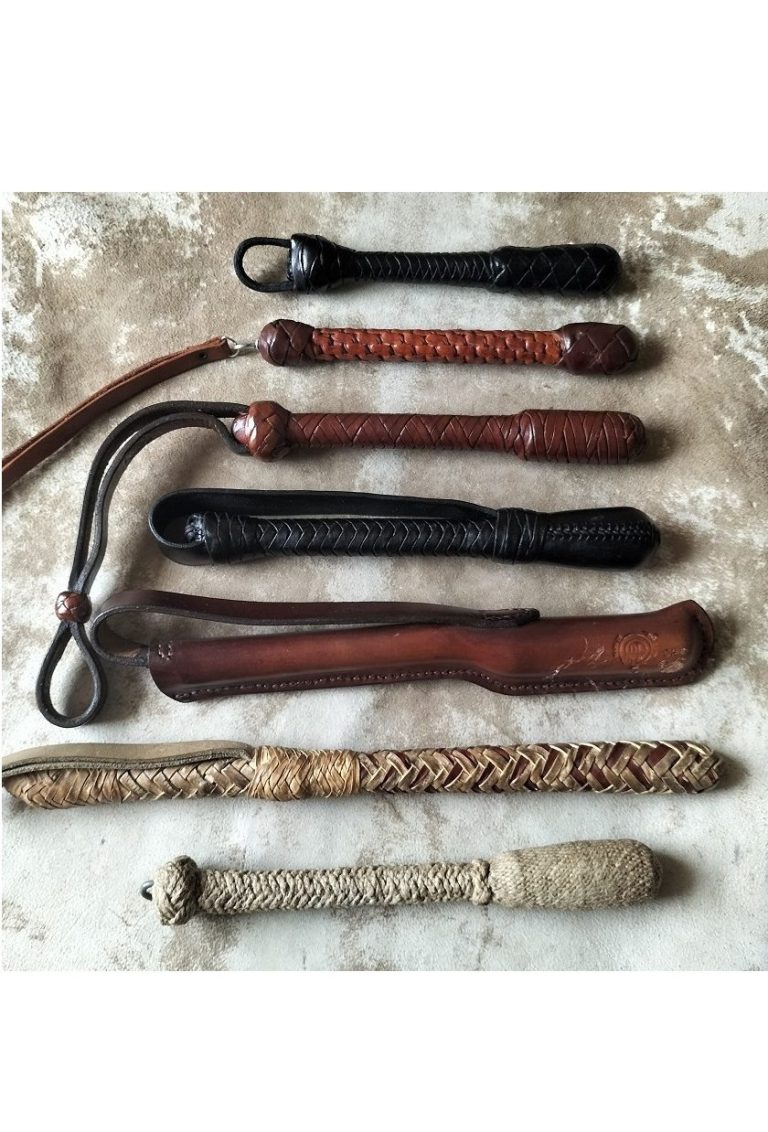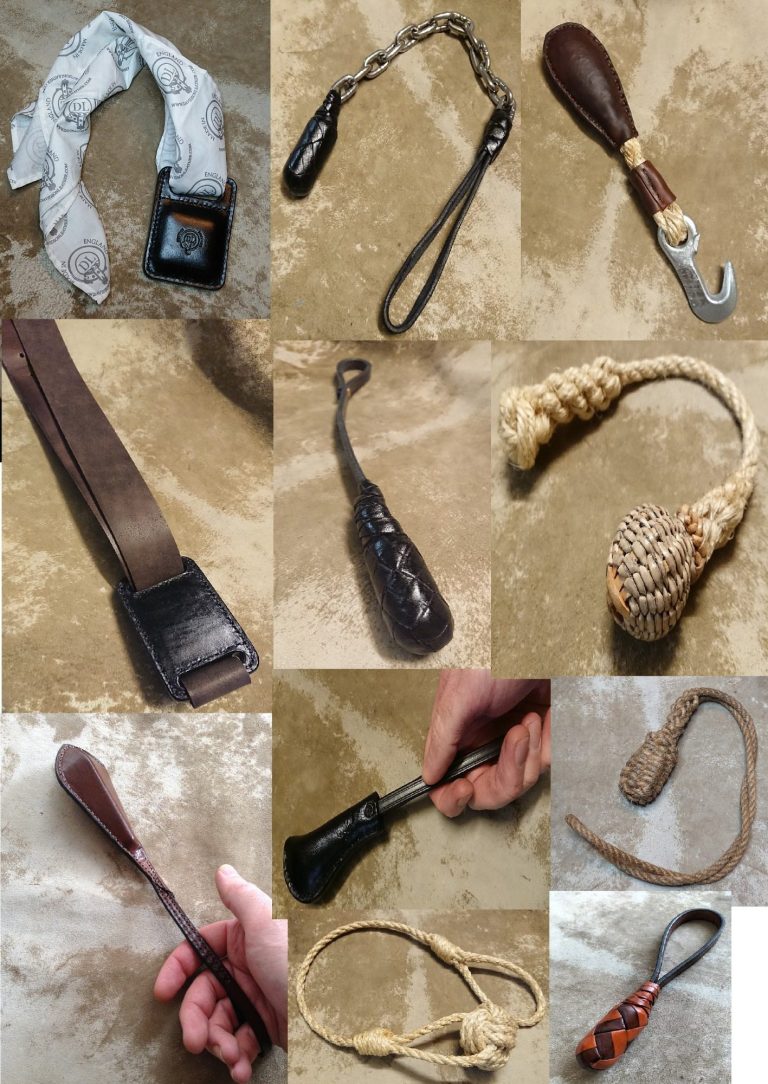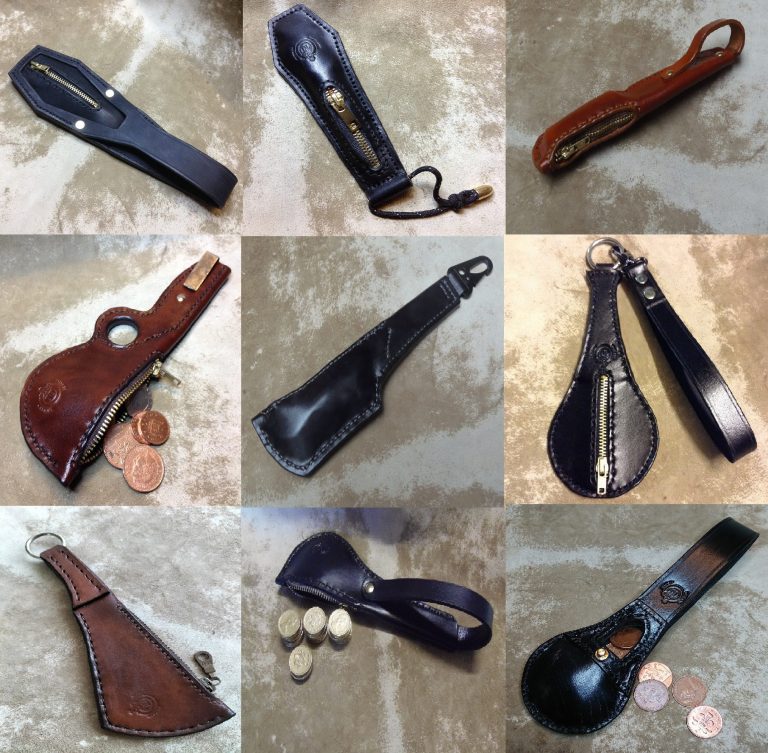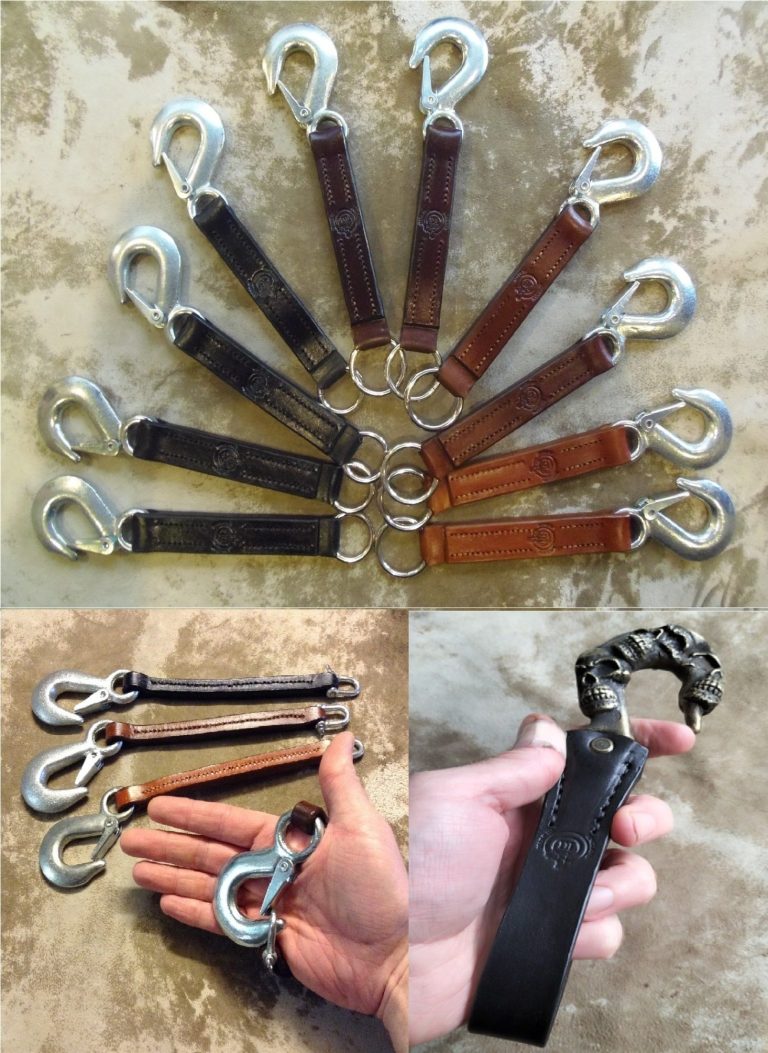Examples and Additional Detail
There are many variations, but even these variations follow a basic set of principles. However there are the weird ones, imagined by an individual based on materials to hand or for a specific use.
I do not promote the usage of any of the following to inflict bodily harm, none of the detail is intended as 'advice', it is supplied for historical information of each type of item, how its made and how it was used. The detail is available if research is done into old police user manuals, reading news articles, police reports, and interviews.

Blackjacks, Twistjacks and Coshes
Main Characteristics
- Lead weighted head - may or may not be visible
- Spring or wire shaft - different types of wire rope (cable), other wire or even a combination can be used
- Generally 5-14" long, some examples can be longer but these are rare and no longer than 27" as the wire rope no longer supports the weight of the lead head
- Covered generally in a leather braid, or a sown leather cover. Some more crude examples could be over wrapped in some sort of cloth, tape or twine
- Depending on their weight, often used on the major muscle groups, lighter ones for head strikes (not recommended due to high probability of causing brain injury)
- Carried by the police, criminals or every day civilians
- Can be used swung or for jabbing into pressure points
Flat Saps
Main Characteristics
- Made with leather layers, the number of layers can vary
- Lead in the for end, one solid lump traditionally cast to a length of spring steel that runs down the shaft to the pommel
- Usually they have some sort of retention strap, whether its an over the back of the hand strap like in the picture, or a wrist thong through an eyelet in the pommel end
- Called flat, as they are mostly flat. In this type of sap there is a slight hump on either side from the dome of the lead
- Can be used for flat strikes to major muscle groups, or an edge strike which, by written accounts, has broken bones
- These were often carried by the police, don't require much training, and were very effective


Soft Saps
Main Characteristics
- Called soft only because the lead is not one solid lump, its either lead shot balls, or lead powder
- Almost always covered in leather due to its durability
- Often these are made with the whole of the inside being filled with lead shot. This doesn't make them ideal as they're heavy and lack forward momentum when swung
- The affect of these is a dead strike where all the impact is transferred into the target, as there is no bounce or snap back, because there is no spring steel in the shaft usually
Palm Saps
Main Characteristics
- Warps around the hand
- Weight is to sit in the palm
- The weight is traditionally solid lead or lead shot balls, however I have made some modern variations which take coins, and ones in the picture which has embedded spikes and the half ball
- Quite discrete to use and carry
- Limited in effectiveness, just adds effectiveness to a slap, accounts exist of it being specifically used to do a surprise hit to the nerve cluster behind the ear which renders the recipient unconscious
- These are not to be reversed and put over the knuckles, this is just stupid, if you were to punch a target with them in that position you're almost 100% likely to cause yourself damage. Hands have many bones in them, small and which can easily be damaged


Billyclubs, Shillelaghs, Knob Kerries
Main Characteristics
- Often quite short, shorter than a walking stick, but longer than blackjacks and saps
- Made of wood mainly, some police batons and extendable batons can be made of metal
- Rarely flexible
- Some may be lead weighted, others have a larger lump of wood on one end which provides the weight
- Used on people and animals, no specific target zones i.e. the knob kerry has a spiked bulbus end specifically designed for causing head trauma

Slungshots
Main Characteristics
- A weight suspended on a flexible length of cord, leather, rope, chain or something similar
- Depending on size these can easily be rolled up to go into a pocket
- Only useful when swung, dead strike force upon impact
- Depending on the length and style of the 'cord', the longer it is, the more effective they are, but also the more dangerous they are to the user
Coin Saps
- Made in all manner of different shapes by various makers around the world presently, even by people that make no other form of impact, or share an interest in the subject
- These are a modern impact weapon, sure people have used coin purses for centuries, and probably hit people with them, but no historical designed coin purse I have seen appears specifically made for this purpose. The Viking version is probably the design that best lends itself to be used as a blunt impact weapon if needed
- Most have metal zips, some makers use plastic zips, some even use dress zips, make of it what you will. A heavy duty metal zip for mine all the time
- Weight is provided by coins. Depending on the design the effectiveness of these can be a placebo. A bad shape or not enough weight can make them utterly useless. My rule is, if you can't get 8oz in it, and you can't securely hold it, you may as well just go without it.


Heavy Hook Impact (sometimes referred to as the tow hook sap in the community)
- A heavy hook on a bit of leather, some are on paracord, others webbing; best to stay clear of those unless you don't mind knocking yourself about
- The metal hook provides the weight
- The bare metal hook is nasty and would result in ripped skin if it came into contact
- Made by different makers around the world, be warned, if the hook rotates there is a high likelihood this cause you injury when trying to use it, and can you really target an impact zone if the weight is travelling in an unpredictable direction?
- Mainly best for large muscle groups, the edge would most certainly give a dead arm/leg, possibly even break bone. Handy if you need something to break up a dog fight; reduces the chance of getting fingers bitten or mauled
The sandbag
There is a saying 'getting sandbagged' this doesn't refer to being put into a sand bag, one of the modern hessian type. The sandbag in the historic sense is a bag made of duck cotton, often an old flour sack or sail, shaped like a club and filled with sand. These can vary in length. I've not seen an existing antique example as cotton does biodegrade quicker than the likes of leather, but drawings do exist. The French Apache version is one. These have been out of circulation probably for well over 100 years.
Dry sand is quite effective giving a dead strike, cotton is porous so the sand could be wet causing it to become more solid and heavier. Having made one, as in the picture, these are not a pocket friendly carry, more likely to have been tucked in a jacket or up a wide sleeve. The one shown here could be carried both those ways.
At the time these would have been cheap to manufacture and readily available, as all flour was is cloth sacks, not paper as they are currently, so readily available especially in cities. It could also easily be discarded after use, or the sand emptied out returning it to just a benign piece of cloth. Unlike a wooden billy club or shillelagh which you need to find a suitable piece of wood, then it needs the wood dried for around one year, these were quicker to make.

There are several variations, cross overs, and some items are hard to categorise as they can fit into several.
We need your consent to load the translations
We use a third-party service to translate the website content that may collect data about your activity. Please review the details in the privacy policy and accept the service to view the translations.
